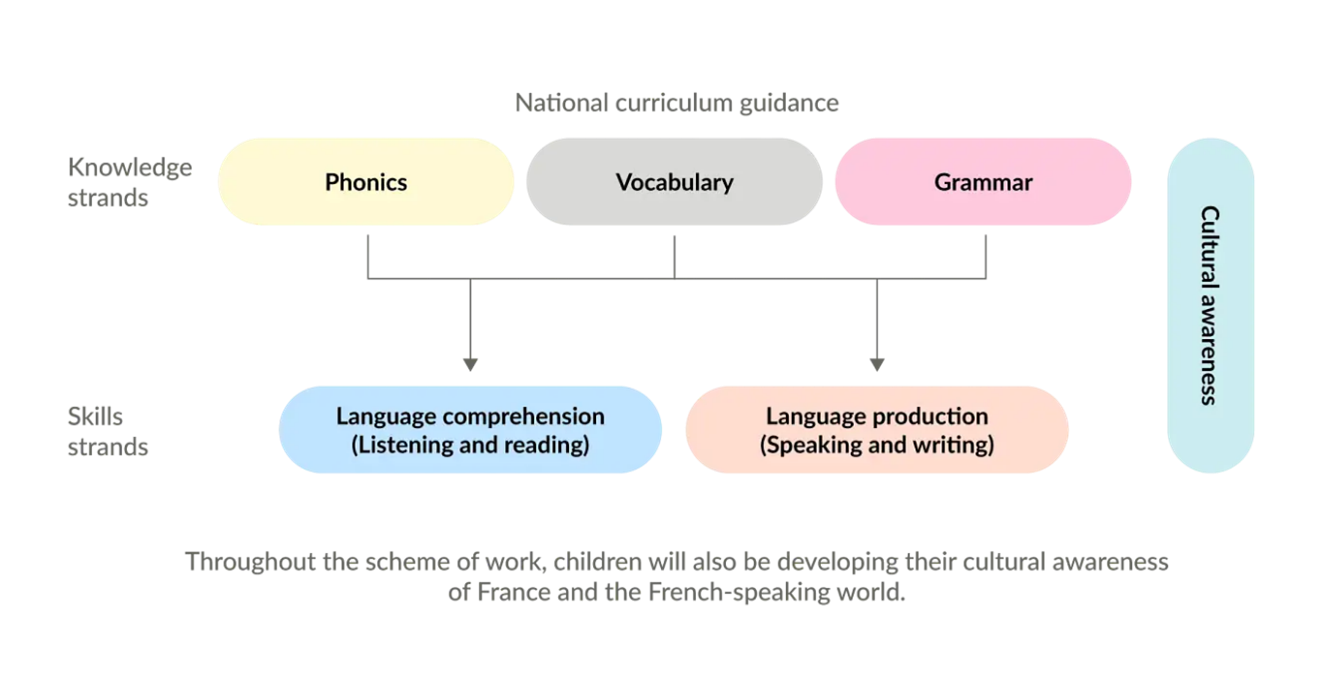MFL Intent Statement
At Thirsk Primary, we teach French so that pupils become curious, confident language learners who are able to speak, read, listen and write in another language – not simply to repeat phrases, but to think like linguists.
Our curriculum develops the core Kapow knowledge strands:
· Phonics – accurate mapping of French sound → spelling → pronunciation
· Vocabulary – high-frequency words stored, retrieved and used automatically
· Grammar – sentence patterns used flexibly in speaking, reading and writing
· Language comprehension (listening & reading) – pupils decode increasingly efficiently by drawing on phonics, vocabulary and grammar
· Language production (speaking & writing) – pupils apply patterns they know independently to communicate meaning
· Cultural awareness – pupils talk and write about elements of French life and French-speaking cultures

Our intention is to support children to:
· build ambitious aspirations beyond their immediate experience – understanding that language connects people, cultures and communities worldwide
· show compassion and respect for others – recognising diverse lived experiences across the Francophone world
· experience genuine inclusion – all children able to participate, achieve and feel represented
Our curriculum design is informed by cognitive load theory. We reduce overload by introducing new learning systematically, building from prior knowledge, and keeping the three pillars of phonics, vocabulary and grammar central. New structures are introduced in small steps, deliberately practised and revisited in varied contexts so knowledge strengthens and becomes automatic. Topic vocabulary is used to provide meaningful contexts, while high-value verbs and patterns are taught to fluency.
By doing so, pupils at Thirsk Primary build secure linguistic foundations and a global perspective – becoming ambitious, compassionate and inclusive communicators who can use French confidently, accurately and with genuine curiosity.
MFL Implementation Statement
We implement our French curriculum in a way that is faithful to our intent and aligned with cognitive load theory.
Practice is structured to reduce overload, strengthen long-term memory and ensure that the three pillars – phonics, vocabulary and grammar – are explicitly, systematically and cumulatively taught.
How lessons work
Each lesson follows a consistent sequence:
|
Phase |
Purpose linked to cognitive load |
|
Recap / retrieval |
activates prior knowledge and secures essential phonics / vocabulary / grammar patterns already taught so working memory is not overloaded by unnecessary new information |
|
Hook |
brief, engaging stimulus that sparks curiosity without adding excess content load |
|
Explicit teaching and modelling |
small steps teaching of core high-value structures; teacher models pronunciation (phonics), sentence patterns (grammar) and meaning (vocabulary) clearly |
|
Guided → independent practice |
carefully scaffolded rehearsal so learners automate key patterns before increasing independence |
|
Review / reflection |
checks understanding; strengthens the retrieval–storage–retrieval cycle |
Adaptive teaching and inclusion
All lessons are built to include flexible scaffolds, multisensory strategies and clear instructions so that every pupil – including those with SEND – can process new information efficiently and meaningfully. The spiral nature of the curriculum prevents sudden jumps in complexity and supports steady, secure progression.
Curriculum architecture
- new content is introduced in small, well-sequenced steps
- high-value verbs and sentence frames are prioritised over topic lists
- prior knowledge is repeatedly recycled in new contexts
- grammar is taught explicitly and returns progressively in greater depth
- phonics is modelled consistently to secure accurate sound–spelling mapping
Knowledge organisers and Kapow CPD resources support teachers to deliver this consistently and with confidence, reducing cognitive load for staff as well as pupils.
MFL Impact Statement
Impact at Thirsk is judged by whether pupils can remember and apply the core pillars of French – phonics, vocabulary and grammar – with increasing independence over time.
Because content is introduced in small steps, revisited regularly and practised through retrieval, pupils are able to store key structures in long-term memory. This reduces working-memory load so that pupils can focus on communicating meaningfully rather than trying to “hold” too much new information at once.
Impact is checked mainly through ongoing formative assessment – questioning, observation, teacher–pupil dialogue, recap tasks and end-of-lesson reflection. These allow teachers to adjust in real time and ensure new learning does not exceed cognitive load limits. Summative elements (Assessment quizzes, Knowledge catchers and the Assessment spreadsheet) provide periodic evidence of durable learning from unit to unit.
Evidence of impact is seen in how pupils pronounce accurately, apply sentence structures flexibly, extend familiar patterns to new contexts and explain what they understand. Written work, oral responses and pupil voice illustrate whether knowledge has been genuinely learned rather than temporarily performed.
Teacher CPD and explicit subject knowledge support ensure staff have clarity over what matters most, so the curriculum is delivered consistently and with confidence.
We expect to see secure development across the knowledge strands used by Kapow to structure progression:
- Phonics – accurate mapping of French sound → spelling → pronunciation.
- Vocabulary – high-frequency words stored, retrieved and used automatically.
- Grammar – sentence patterns used flexibly in speaking, reading and writing.
- Language comprehension (listening & reading) – pupils decode increasingly efficiently by drawing on phonics, vocabulary and grammar.
- Language production (speaking & writing) – pupils apply patterns they know independently to communicate meaning.
- Cultural awareness – pupils talk and write about elements of French life and French-speaking cultures.
Impact is visible in how confidently pupils transfer familiar structures into new contexts, how accurate their pronunciation becomes, and how efficiently they retrieve prior knowledge during routines such as recap tasks. Written outcomes, spoken responses and pupil voice provide the main evidence that French is not just taught but learned – securely, cumulatively and with reduced cognitive load.
